Asset management digitalisation: Is the dam about to break?
By Said Fihri, KPMG in Luxembourg
Published: 20 September 2022
What happened to asset managements’ digital revolution? For some years now, there has been promised transformation in the funds sector — a round of digital upheaval that would reconfigure the industry for good. But while some digital initiatives have moved forward, that ‘big bang’ moment has proved elusive. Above all, this is still an industry that develops products and then tries to sell them to its customers; for many asset managers, the concept of customer centricity remains out of reach.
Perhaps there should be no surprise at such slow progress. Asset management, after all, is an industry that is highly dependent on the intermediaries that sit between product producers and the investor. These vested interests have powerful reasons not to welcome the digital transformation that takes asset managers closer to their customers.
Self-disruption, in any case, can be difficult to do. Incumbents with legacy systems — and legacy ways of thinking — find it hard to transform. That has been the experience of many industries. New entrants able to develop digital-first businesses from scratch naturally get there more quickly.
For all that, however, it would be a mistake to see digitalisation delayed as digitalisation denied. Change is coming to the sector and time appears to be running out for the incumbents to adapt. This may be evolution rather than revolution, but the laggards will likely still be left behind.
Here come the robots
Take the rise of robo-advice, where the idea of automated and programmatic fund selection is resonating ever more strongly with a growing pool of investors. Robo-advisors are now looking after assets under management worth billions of pounds. Worldwide, the robo-advisory market is now expected to grow at a rate of almost 40% a year, over the next five years. 1
No wonder. In a marketplace where high-cost, actively-managed fund strategies have continued to disappoint — with both asset managers and intermediaries taking their cut — the low fees charged by robo-advice services are appealing. Moreover, a new generation of investors feels comfortable transacting digitally — robo-advice is just another service accessed through a smartphone app.
COVID-19 also accelerated the shift to robo-advice. Even those investors able and willing to pay for face-to-face financial advice were denied access to these services. Every part of the market became more familiar with managing their lives digitally.
Digital engagement at last
More broadly, both asset managers and fund distributors — even the incumbents — have invested substantial sums in their digital propositions. The web-based interfaces through which investors research and place their trades are more user-friendly than before. Online fund platforms have become the default route to market for investors in many European markets and offer access to a growing range of assets in addition to collective investment vehicles — from direct equities to digital currencies.
This is what many customers want. Fewer investors, even in the high-net-wealth bracket, are impressed by plush offices and lavish hospitality and they no longer want to travel to meetings to talk through their options in person with an adviser. Younger investors, in particular, are shunning direct contact, at least in a conventional sense, and some are engaging via social media. 2
The effect, slowly but surely, is expected to bring asset managers closer to their customers. Indeed, fund platforms offer a means for managers to build more direct relationships with their customers.
With that more direct relationship comes the opportunity to get to know customers more intimately than ever before, which can enable asset managers to design products tailored around the needs of individual customers, rather than pursuing growth through an endless round of new fund launches.
Blockchain helps transform distribution
Elsewhere, the building blocks are already in place for a new model of fund distribution. There are no technical or regulatory barriers standing in the way of the use of distributed ledger technology for distribution and the potential benefits of this shift are multiple.
Blockchain-enabled distribution can offer increased transaction speed, reduced reconciliation requirements, lower costs and swifter collaboration between each member of the value chain, whether asset managers are dealing directly with investors or via distributors.
In fact, the potential for disintermediation is clear. By removing the paper-based administrative burden from the distribution process, where asset managers need support from intermediaries, blockchain solutions can help bring down the cost of customer acquisition and make it easier to deal with retail investors at volume.
Again, the opportunity is for asset managers to move closer to their customers, particularly as this model of distribution enables a far more seamless exchange of data.
Data can help drive operational efficiency
Asset managers shouldn’t overlook the advantages of digitalisation in their back- and middle-office operations. This aspect of asset management remains mired in legacy process, with a complex web of in-house and outsourced services providing administrative support to fund distribution. Now, however, new digital solutions offering greater transparency and control are springing up.
There is more to come. One problem for asset managers is the disparate array of processes and systems through which the industry operates. The absence of a common framework for the industry can drive inefficiency and cost. Blockchain, however, provides the potential to develop such a framework.
In other words, across the sector, transformation is now underway. And while the question of when the trickle will become a torrent is difficult to answer, the process of change has begun. Asset managers recognise the grip that intermediaries have on the marketplace, but they also see the potential of digital transformation to loosen that grip — both in the way they work with intermediaries and in how they develop more direct relationships with investors.
Time may be running out to embrace that change. New entrants to the industry will bring disruption of their own. Such competitors may come from a technology background — for example, the tech giants have been moving at pace into payments. Or they may come from elsewhere in the financial industry. Tech-enabled innovators in areas such as digital currency trading, for instance, have an opportunity to move into more traditional asset classes.
Either way, competition is coming. Those asset managers that remain passive in their approach to transformation in this fast-moving marketplace should embrace change to keep up.
1 Global Robo Advisory Market Expected to Rise at a CAGR of 39.9% and Surpass US$59,344.5 Million during the Forecast Period from 2021 to 2028 [228-Pages] | Confirmed by Research Dive, GlobalNewswire, March 2022
2 Op-ed: Advisors must meet the digital demands of young, Mike Boese in CNBC, April 2021.



